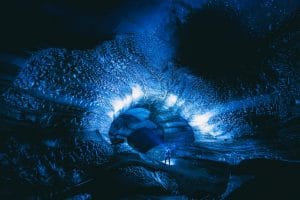Par Jonathan Duffy, Arctic Meta
Volcanoes are more than just the reason the main characters had to return to the dinosaur island in Jurassic World Fallen Kingdom. These natural wonders are impressive, explosive and basically the reason we have ground to stand on.
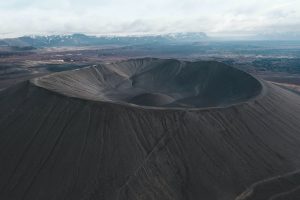
A volcano is a mountain that opens down into the Earth’s core. It creates a hole in our planet’s crust that molten rock or ‘Lava’ can escape through after enough pressure has built up.
The Earth is made up of several plates of land called ‘Tectonic Plates.’ They fit together a bit like a hand-me-down jigsaw puzzle with corners that are just a bit warped. The points where these plates meet are known as ‘Ridges’, and these ridges are weak spots where lava from the centre of the Earth creates pressure and can escape.
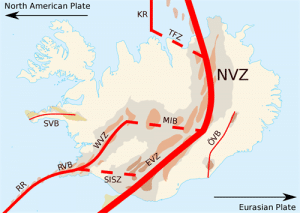
Photo: Mid Atlantic Ridge from Katlageopark
Ever since our planet managed to get water (that’s a whole other scientific conversation), the relationship between that water and lava is the reason we have land. Basically, lava pops out of the crust of the Earth, it’s cooled by the sea (or sometimes the air, but that takes a lot longer), then over time, it becomes rock again.
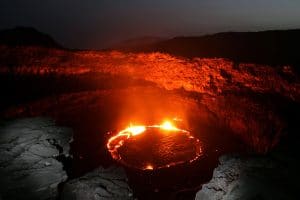
Now cue the first song from the lion king because even lava has a ‘circle of life.’
Once the rock has cooled, it’s also pushed and pulled around over millions or billions of years and sometimes it is forced into a place where more lava is escaping the Earth. It is then sucked back into the core and melted down before the cycle begins again.
There are weak spots in the crust worldwide, and volcanoes appear on most of them. Notable volcanic regions include Indonesia, New Zealand, Japan, Costa Rica and Italy.
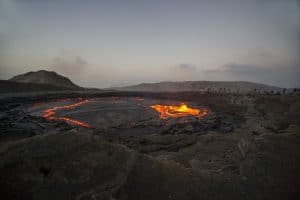
One of the most Northern regions of the planet to experience volcanic activity in Iceland. So How many volcanoes does Iceland have? How many are active? Which one is the biggest? All these questions and more are answered below.
How Many Volcanoes Are There in Iceland?
There are at least 130 volcanoes in Iceland. That might sound like the entire country is just a bubbling pot of lava waiting to burn everything, but it’s not the case. Many of the volcanoes in Iceland haven’t shown any activity in a long time.
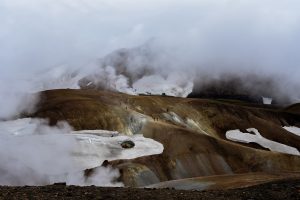
Volcanoes can be found throughout the entire landmass of Iceland. The majority of the island experiences a great deal of geothermal activity except for the Westfjords. The reason for this is that this region of the country is the oldest part. It is a bit far away from the Mid-Atlantic Ridge to experience much volcanic activity. This is also why the Westfjords is the only part of Iceland that uses electricity to create heat instead of geothermal hot water.
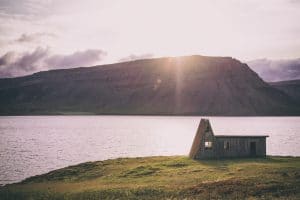
There are three ways a volcano is classified when it comes to activity, these are Active, Dormant and Extinct.
For a volcano to be classified as active means, it has had some eruptions in recent history and is likely to erupt again in the future.
When a volcano is dormant, it means there hasn’t been an eruption for a long time, but it’s believed there still might be some activity in the future.
An extinct volcano hasn’t erupted in a long time and is believed to have no activity in the future at all.
How Many Active Volcanoes Are There in Iceland?
Of the 130 volcanoes in Iceland, around 31 of them are considered to be active. This number can always change because there’s never really a 100% sure way of knowing if a volcano is extinct or dormant.
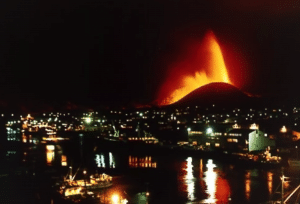
There was a volcano off the South Coast of Iceland in Vestmannaeyjar (the Westman Islands) called Eldfell that was believed to be completely extinct because it hadn’t erupted in over 5000 years.
The status of Eldfell swiftly changed in 1973 when it suddenly erupted and destroyed over 400 homes on the small island of Heimaey.
The eruption didn’t last too long, and the small island’s residents were eventually able to return home to watch ABBA win Eurovision with Waterloo in 1974.
What Are the Most Active Volcanoes in Iceland?
Of the 31 active volcanoes in Iceland, a few tend to go ‘boom’ a bit more often than the others. This may surprise you, but most of the active volcanoes in Iceland are located in the south.
This may make you wonder why anyone would choose to live there. If you were to ask a local, they would probably respond in a typically calm and unshakeable Icelandic way with something like, “It’s not like the volcanoes erupt every day.”
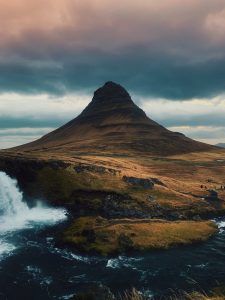
The south is also home to some of the most picturesque and unique attractions Iceland offers. Places like Reynisfjara Black Sand Beach, Jökulsárlón Glacier Lagoon, the Diamond Beach and many glaciers are all in Iceland’s South and can easily be visited on an Iceland south coast tour. Volcanoes are a massive part of what has shaped this landscape.
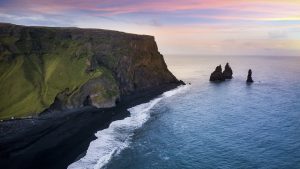
The southern part of Iceland is also home to some of the best farmland in the country. So if you could have a profitable farm in one of the most beautiful parts of Iceland, I think you’d probably put up with the possible inconvenience of a volcanic eruption or two.
Grímsvötn

Photo Credit: Roger McLassus via Wikimedia C.C.
Grímsvötn is, by far, the most frequently erupting volcano in Iceland. It is in Vatnajökull National Park in South Iceland and is entirely covered by the Vatnajökull Glacier. In the past 800 years, Grímsvötn has erupted at least 65 times, with the most recent eruption in 2011.
Katla
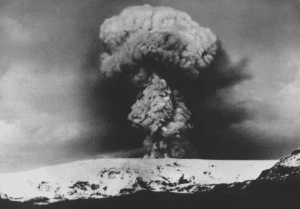
Katla volcano is also in southern Iceland. She’s one of the most powerful and explosive volcanoes in the country. Katla has erupted at least 20 times since 930AD, and the last major eruption was in 1918 which lasted for 26 days. Katla is also responsible for 4% of the carbon dioxide emissions on the planet.
Hekla
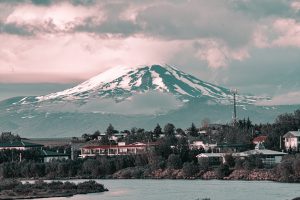
Hekla also lies in the south and is one of the most famous volcanoes in Iceland. During the middle ages, this stratovolcano was nicknamed ‘the gateway to hell.’ This legend persisted throughout most of Europe right up till the 19th century.
Hekla’s eruptions have been so powerful that a volcanic rock called ‘tephra’ from this specific volcano can be found throughout the country. In fact, 10% of all the tephra in Iceland can be explicitly traced to Hekla. Hekla’s last eruption helped bring in the new millennium on February 26, 2000.
Barðarbunga
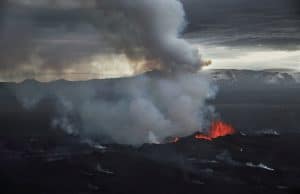
Barðarbunga is also in Vatnajökull National Park and sits at the height of 2009 m (6591 ft), making it the second tallest mountain in Iceland. Even its name sounds explosive (Bar-the-boong-ga). The last time we heard from this giant was in August 2014, when an eruption began after 1600 earthquakes were recorded at the mountain in 48 hours.
Geldingadalir
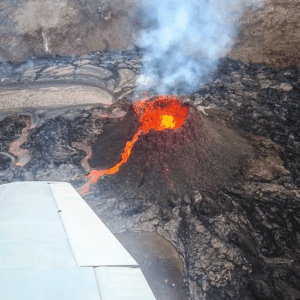
Ironically, the same day as this article was published Iceland experienced another volcanic eruption at the newly named Geldingadalir volcano, located by the mountain of Fagradalsfjall on the Reykjanes peninsula (not too far from Keflavík international airport).
At the time of writing, as the volcano is only around 50km from the capital city of Reykjavík, on a clear day you can see the ember sky of the eruption in the south – even better views can regularly be spotted by the town of Hafnarfjörður.
This eruption occurred after an intense period of seismic activity on the peninsula after a resulting 50,000 recorded earthquakes since February 24th 2021. After weeks of speculation from various volcanologists, on the 19th March 2021 Geldingadalir finally entered the world, with a surreal outpour of lava on a peninsula which hadn’t seen a volcanic eruption since the 13th century.
Fortunately, the location of Geldingadalir is placed in a valley well away from local communities, meaning the impact to human life remains low. This volcano also won’t produce an ash cloud like Eyjafjallajökull, but instead will produce a steady stream of lava flow which is earning it the nickname as the tourism volcano with planned excursions already well in the works for a post-covid world.
However, aside from the enjoyment locals have experienced in Instagramming this eruption, from cooking bacon on the lava flow (stupidly!) to bizarre rollercoaster drone rides for Youtube that will leave you googling anything apocalyptic, it is not yet known how long this eruption will last. Some experts had claimed a few days, others weeks, and some much longer than this.
The Different Types of Volcanoes in Iceland
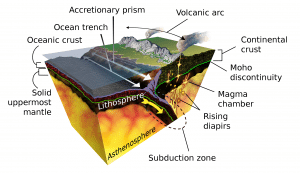
Photo Credit: KDS4444 via Wikimedia C.C.
There are two main types of volcanoes in Iceland. The most common type is ‘Stratovolcanoes’ which stretch out in a line. They’re basically a series of mountains that have veins beneath them filled with lava.
Lots of them are connected to each other, so when pressure builds up, the eruption can be from any of the volcanoes connected to that system.
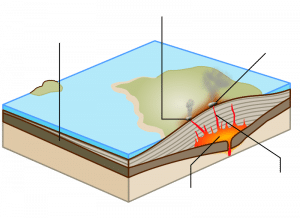
Another type of volcano is a ‘Shield Volcano’, which looks like a shield placed upside down on the ground. They are more curved and less of the typical conical volcano shape we are more familiar with.
There are also different kinds of eruptions that volcanoes can have. Most people are familiar with the type where the lava comes out of a giant cone’s centre. This kind of eruption is called a ‘Caldera Eruption.’
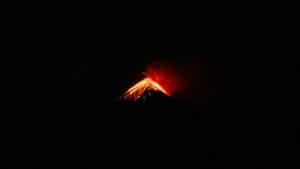
When the ground seems to have a tear or crack in it like it has been forced open, this is called a ‘Fissure’, and eruptions can happen here too.
What’s the difference between a caldera eruption and a fissure eruption? In the simplest terms, caldera eruptions are a bit more ‘kaboom’, and fissure eruptions tend to be more ‘oozy lava.’
When Did the Last Volcano Erupt in Iceland?
This piece of information literally changed the day this article was produced when Geldingadalir volcano made its debut eruption on March 19th 2021. This was the first eruption experienced on the Reykjanes peninsula (south-west Iceland) since the 13th century – you can see how regular eruptions are and how difficult it can be to keep on top of when you’re writing about them!
Volcanoes don’t erupt every day in Iceland, but there have been a few that seem like they’re about to for a little while now, so, at the time of writing this blog, the last volcanic eruption was in 2010.

Many remember this particular eruption because it caused a lot of bother for lots of people throughout the world. You might also remember this volcano because, for non-Icelanders, its name seems impossible to say.
On March 20, 2010, Eyjafjallajökull erupted and immediately struck fear into the hearts of any news reporters who attempted to pronounce it. Below is a news story about precisely that from CNN in 2010.
The volcano’s name means ‘Island Mountain Glacier’, and the 2010 eruption halted air traffic across Europe.
A decade earlier, NASA discovered that ash from a volcano’s plumes can catastrophically damage aircraft instruments and cooling systems after an incident where one of their planes flew over Hekla. This is why air traffic completely halted after the eruption in 2010.

Photo Credit: Árni Friðriksson Wikimedia C.C.
The fallout from Eyjafjallajökull caused billions of dollars in loss for airlines and left millions of passengers stranded with no way of getting home. The volcano was officially declared dormant in August of 2010.
Experts believe the most likely volcano to erupt next in Iceland is Þráinsskjaldarhraun which is definitely more of a nightmare to pronounce than Eyjafjallajökull. Still, if you want to get some practice in, you can try saying it like ‘Throw-ins-sk-yal-dar-ha-rone.’
What is the Biggest Volcano in Iceland?

The largest active volcano in Iceland is Öræfajökull. This is another one of those volcanoes in Iceland who’s name requires you to make sounds that don’t naturally occur in English. Öræfajökull is entirely covered by Vatnajökull Glacier in the South of Iceland.
Its highest peak is 2110m (6920 ft). It has only erupted twice in recorded history, but each of these was quite a destructive event.
In 1362 the volcano erupted, causing floods that wiped away farmland and a small town. The ash cloud from this eruption moved all the way to Western Europe. People were unable to return to the town that was destroyed for 40 years.
Upon their return, the people named the town Öræfi, which literally translates to a place without a harbour’ and in this context means ‘wasteland.’ The biggest active volcano in Iceland’s name means ‘Wasteland Glacier’ which sounds like a place in a Mad Max film.
What Was the Largest Eruption in Iceland?
As mentioned earlier, the Katla volcano is one of the largest and most powerful in Iceland. There is a fissure that is part of the same volcanic system as Katla called Eldgjá. Its name means ‘Fire Canyon, and it’s easy to see why.
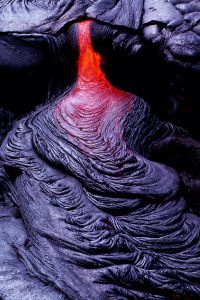
In 935 AD, Eldgjá began erupting, and it is believed it didn’t stop for between 3 and 8 years. During this eruption, the volcano spewed nearly 20 cubic kilometres of lava over an area that covered 800 square kilometres.
This makes Eldgjá’ technically’ the largest eruption ever in Iceland, but there’s another more destructive one you should know about.
Are you ready for a brilliant case of ‘The Butterfly Effect?’
On June 8, 1783, a volcanic fissure in the south of Iceland called Laki erupted. The eruption lasted for 8 months and devastated the people of this tiny island nation. Much of the country’s livestock and agriculture was destroyed, and it’s believed a quarter of Iceland’s population died in the years following due to famine.
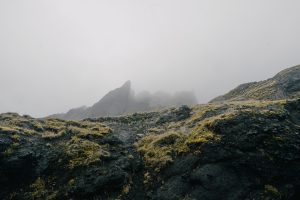
The ash cloud from Laki was picked up by the ‘Jet Stream’, a consistent flow of wind that moves from North America and across Europe.
The jet stream carried the cloud across Western Europe, Scandinavia, Great Britain, North America and even as far as North Africa.
Ships were unable to sail because of poor visibility, crops failed, livestock died, and weather patterns were disrupted. The dark skies and famine were also followed by an unusually harsh winter, felt through most of the Northern Hemisphere, making matters worse for everyone.
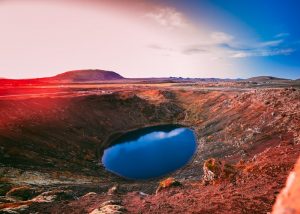
The effects of Laki were experienced for at least three years, and it is believed at least 5 million people died as a result, but that’s not where this volcano’s influence ends.
Many historians agree that the poor conditions and famine caused in Europe by Laki lead to the French Revolution, which began in 1789.
So the next time you enjoy a croissant, take a moment to think about the little Icelandic volcano that helped turn France into the democracy it is today.
If you are wondering why they didn’t teach you that in school you’re not alone, below is a video of Richard Saul Wurman, the founder of TED, excitedly talking about this incredible piece of modern history, so few people know about.
How Does Iceland Prepare For Volcanic Eruptions?
I once worked as part of a team of writers for a company in Reykjavík. Every Friday, we would plan the articles to be posted over the weekend and designate whose turn it was to take the news stories’ reigns if Katla went off.
Yes, it was a legitimate thing. There was a process for what would happen that weekend if one of the most powerful volcanoes in Iceland erupted. There was even a skeleton story pre-written with blank spaces for information like date, time, evacuations and whatever else might need to be relayed quickly.
Icelanders have been waiting for Katla to go off for over 100 years. This is interesting because never before in recorded history has 100 years passed without Katla putting on a show. To put it simply, she’s long overdue.
In the towns around Katla, there’s a bit of a joke saying, “If you sneeze next to Katla, a seismologist in Reykjavík will analyse it.” It’s meant to be a bit of a shady poke at how often the public has been told about tremors around Katla.
The point to take from this joke is that all the active volcanoes in Iceland are intensely monitored. There are evacuation procedures in place as well as warning systems that can alert people via text message. There has even been talk of using drones to check areas where mobile phone service is low.
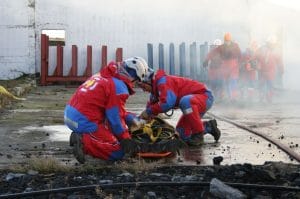
Photo Credit: SAR.com
The seismologists, Icelandic Bureau of Meteorology, Icelandic Search and Rescue, Emergency Services and many other groups work together in these circumstances to make sure all inhabitants and visitors of the area are safe.
If you have spent over 1000 years living alongside volcanoes, you get pretty good at figuring out what to do when one erupts.
Conclusion
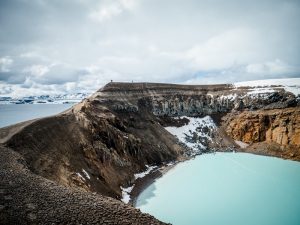
This tiny island nation is nicknamed ‘The Land of Fire and Ice’ for a reason, volcanoes are dotted throughout the country. From moss-covered lava fields to beaches with black volcanic sand, these geothermal wonders have shaped every part of Iceland’s landscape.
If you were to drive around the famous Ring Road, you would notice that the landscape can completely change in an instant. From glistening waterfalls that look like they could be the cover art for a fantasy novel to stark rocky landscapes that have often been used as alien planets in movies, all of this is the work of volcanic activity.
The people of Iceland are known for their laid back attitude, and perhaps that is a side effect of living alongside volcanoes for over a thousand years. One thing is certain, though, when the next eruption happens, Icelanders will continue with their lives just as they did before. After all, ‘It’s just a volcano.’

